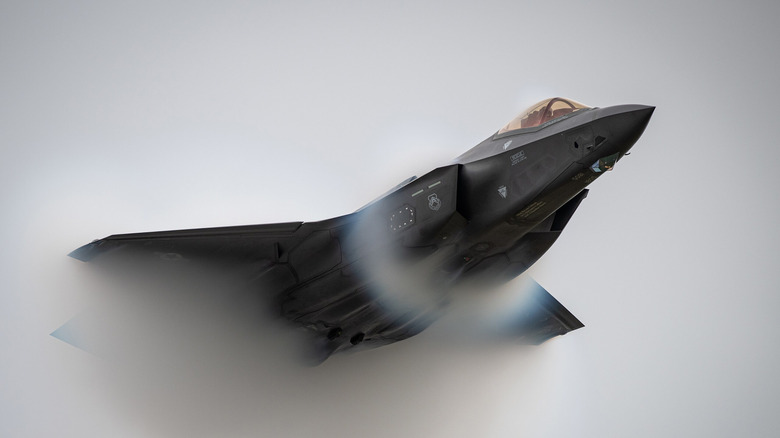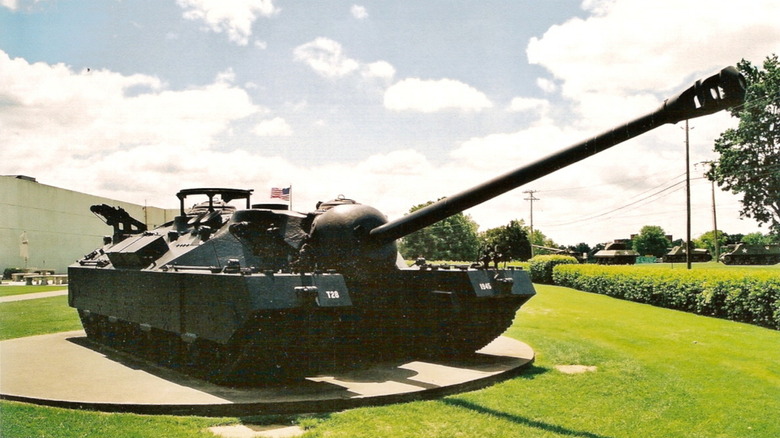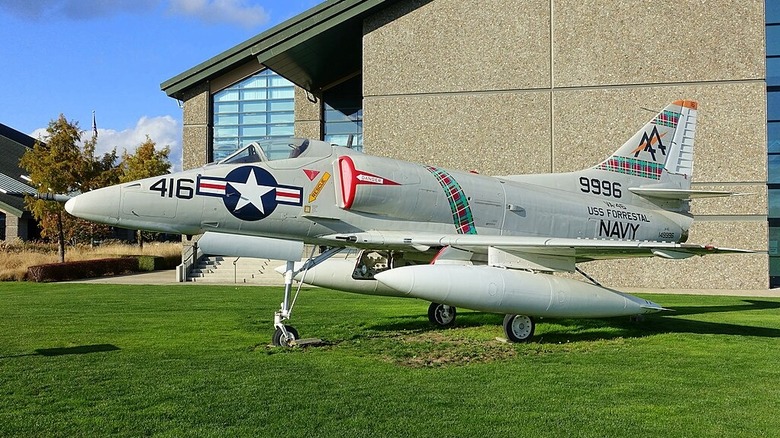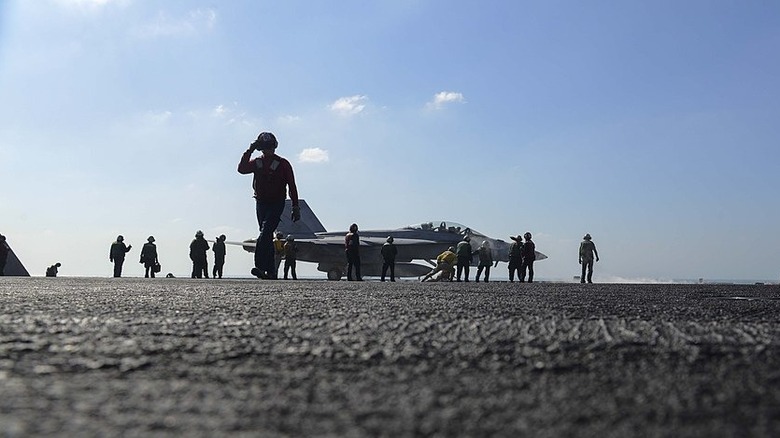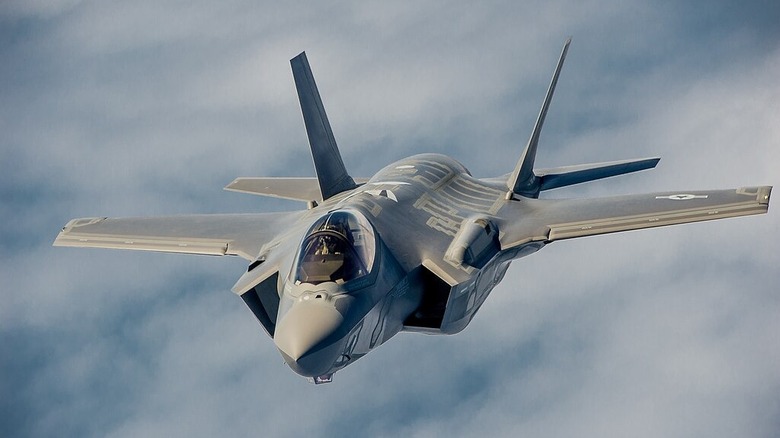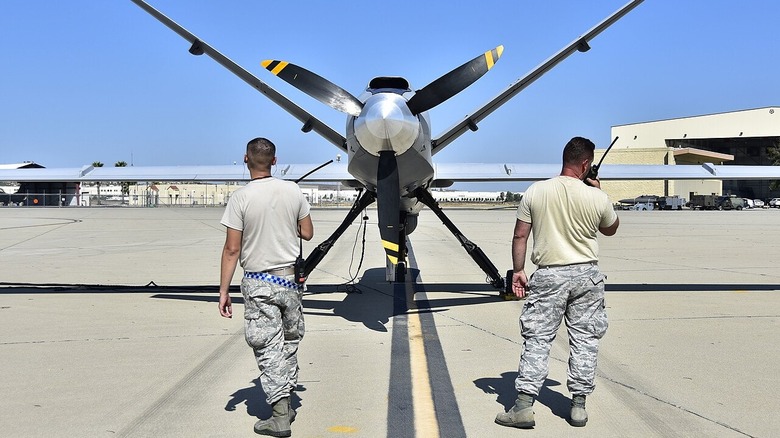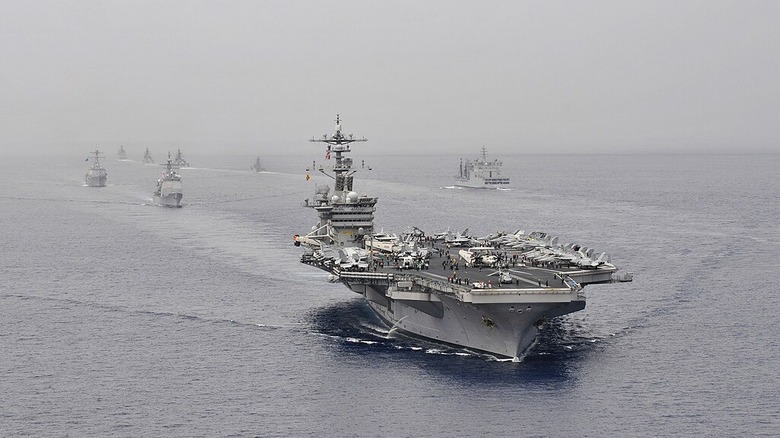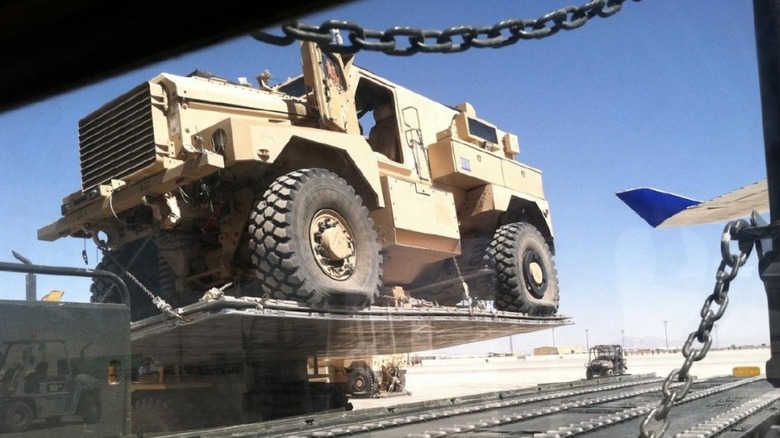The Most Expensive Equipment & Weaponry Lost Or Left Behind By The US Military
In 2024, the Department of Defense requested a budget of $849.8 billion for 2025. While those billions of dollars are nothing to scoff at, the request was actually lower than the budget for 2023. Some changes to the budget for the 2025 request include items like an Army aircraft divestment increase, with reductions in aircraft divestments for the Air Force, Navy, and Marine Corps. With that much money being poured into military operations, it's not the wildest thought to imagine that the U.S. military is spending millions of dollars on equipment and weaponry.
Not only is building military equipment and weaponry expensive, but so is operating it. The ongoing multi-hundred-billion-dollar military budget covers many things, from commissioning new aircraft to maintaining them. Flying U.S. military aircraft costs tens of thousands of dollars per hour. But what happens when that aircraft — or other equipment and weaponry — gets lost?
Unfortunately, the U.S. military has had quite a few instances of missing or left-behind equipment. In some cases, that equipment costs anywhere from millions to billions of dollars. Here are some of the most expensive losses and abandoned military items with price tags that are hard to believe.
A prototype WWII Tank
While it's hard to come by pricing sheets for WWII tanks, any tank designed in the 1930s or '40s would be worth much more money now, whatever its original sticker price. For one tank, though, the price didn't seem to matter, nor was the tank considered especially valuable, as it was once lost for nearly 3 decades.
The T28 Super Heavy Tank was the largest in American military history, and the prototype received a fair amount of attention when it first rolled out of the factory. Designed by the U.S. Army, the T28 had massive armor and aimed to fight back against German tanks. In fact, rather than being a true tank, the T28 was more like a weapon on wheels, without enough fortification in the rear to help protect it against enemy fire.
In the end, while the development of the Super Heavy T28 tank was impressive, it took too long for the vehicle to be ready for the war. Then, one of the few prototypes was parked in a field and abandoned for nearly 30 years. As expensive as it might have been to produce, quickly becoming a historic artifact, the tank was overlooked for a long time before someone reported finding it in a field, bushes growing around it, at Fort Belvoir in Virginia.
$10 million Douglas A-4E Skyhawk (and nuclear weapons)
Some more recent stories may sound eerily similar, but losing aircraft in the ocean is apparently nothing new for the U.S. military. In 1965, an attack plane was lost at sea, but not while it was flying. A Douglas A-4E Skyhawk was lost off an aircraft carrier in a tragic incident. The aircraft reportedly rolled off the elevator of the aircraft carrier USS Ticonderoga, over 500 miles out in the Pacific Ocean. The location wasn't reported, however, and the incident itself was not disclosed until many years later. Sadly, when the plane fell into the ocean, the pilot was inside and did not survive. The nuclear load was not recovered, nor were details revealed about what mission the aircraft was about to embark on.
Not only was the loss of the pilot devastating, but the Skyhawk and its nuclear cargo would have cost a ton of cash. The aircraft itself cost around $860,000 in the 1960s, which would amount to about $8.6 million today. There's no word on the specific nuclear load the plane was carrying, nor how much it was worth, but it can only be assumed the cost would have been massive.
$60 million F-18 jet
In a more recent mishap on board an aircraft carrier, a multi-million-dollar jet rolled right off the deck and into the ocean. An F/A-18E Super Hornet fell overboard from an aircraft carrier in April 2025, costing the military over $60 million. According to reports of the incident, the jet was inside the hangar bay aboard the USS Harry S. Truman and connected to a towing tractor when it was lost.
Fortunately, though the military lost millions of dollars as the jet and its tow vehicle fell overboard, no pilot was involved in the accident. One sailor sustained a mild injury, but the biggest blow to the Navy will likely be the cost of the F-18. Not only that, but mere days after that jet was lost, a second F-18 was lost in the Red Sea after an issue during landing. The F-18 did not catch the wire upon touchdown, crashing into the sea as its aviators ejected.
Another aircraft was also lost at sea, again from the same aircraft carrier, back in 2022. However, at that time, the aircraft was retrieved after being blown overboard. In the case of the F-18 from 2025, given where the incident occurred, it's not clear whether the Navy will attempt to retrieve the fallen jet. At the time of the mishap, the USS Harry S. Truman was completing a mission in the Red Sea.
$72 million F/A-18F Super Hornet
In yet another incident featuring an F-18 Super Hornet, the Navy managed to lose a jet over the sea immediately after it took off. In 2015, the Navy lost an F/A-18F Super Hornet after a malfunction that took out the aircraft's power. The pilot and copilot bailed out of the plane over the Persian Gulf shortly after takeoff. They were rescued from the water by the USS Theodore Roosevelt, but no word on what happened to the aircraft afterward. One specific detail, however, was that the Super Hornet was a total loss.
While the exact cost of an F/A-18F Super Hornet is up for interpretation (and depends on what gear the jet is equipped with), news organizations estimated that the aircraft cost around $60 million in 2015. Based on SlashGear's math, the F/A-18F likely costs around $72 million today. That is slightly lower than the equivalent of 2015 values today. Either way, each time the military loses or leaves behind an aircraft, it costs many tens of millions.
$75 million B-29 Superfortress in Lake Mead
In the 1940s, the B-29 Superfortress was designed for war, but one particular plane had a different job. According to the National Park Service, the Superfortress that eventually crashed into Lake Mead was previously employed as a flying laboratory and was tasked with exploring cosmic rays. Specially selected for the job, the Superfortress was able to carry a bunch of scientific equipment and safely transport the scientists and their gear to over 30,000 feet.
After a fateful mission, one B-29 Superfortress crashed into Lake Mead as the pilot misjudged the altitude. While all the occupants of the plane were able to exit the aircraft, it sank into the lake and was left behind as four Air Force personnel went to the hospital and then moved on in their careers.
Although it was perfect for the high-flying science missions, the B-29 was also one of the most expensive military aircraft ever built. It was so expensive to build the first B-29s that the development process cost about $9 million, or $ 75 million in today's money. At least one order pegged the value of a YB-29 at just over $1.4 million each. Yet when the B-29 that crashed into Lake Mead was deemed unrecoverable, the Air Force didn't replace the plane in the cosmic ray mission. Today, the B-29 in Lake Mead is still monitored, though the Air Force has never attempted to retrieve it from where it lies at a depth of 280 feet.
$85 million in spare parts
Though the military has lost or abandoned plenty of equipment throughout history, it isn't directly responsible for each loss. One example is when a military contractor lost millions of spare parts for high-end aircraft. Reports from the U.S. Government Accountability Office detailed the military's plans to spend $1.7 trillion on the F-35 aircraft. One intriguing footnote in that plan is the fact that the Department of Defense (DoD) owns many spare parts for F-35s, but those parts are managed by contractors.
In one example from the Government Accountability Office, the DoD reported around a million lost parts that were worth a collective $85 million. Citing the lack of a formal process for reporting such losses, the Accountability Office added that the same contractor also failed to report around $66 million worth of parts for review.
After the report, which came out in 2023, the Department of Defense agreed with the Government Accountability Office's recommendations for developing policies that would help track DoD assets. However, as of writing, the status of those recommendations remained open, meaning the DoD had not fulfilled the recommendations yet.
A $100 million F-35 jet
Spare parts aren't the only thing that's pricey about the F-35. Like many other military aircraft, an F-35 jet is quite expensive. There are many hidden costs involved with the F-35, including tens of thousands of dollars per hour of fuel, but its up-front price tag is also massive at around $110 million. Sustaining the F-35s, from maintenance to updating the aircraft, costs billions of dollars, with the total project exceeding $2 trillion even as the military plans to use them less, according to a U.S. Government Accountability Office report.
All this to say that when the military lost an F-35 jet — literally not knowing where it went after a mission went awry — the expense was jaw-dropping. In January 2024, the Marine Corps called 911 to report a missing F-35 after the pilot ejected and the aircraft kept flying. While the pilot was flying over South Carolina, an unknown issue occurred that led to the pilot ejecting from the aircraft.
The pilot parachuted into a resident's backyard, but until the Marine Corps knew the pilot was safe, it reported both the jet and pilot missing. Ultimately, the F-35 went down about 75 miles away from where the pilot landed safely, not harming anything other than the Department of Defense's wallet.
$210 million in drones
The United States military has been involved in the conflict in Yemen since 2015, no doubt utilizing plenty of expensive equipment, weapons, and vehicles. However, only recently were major financial losses reported as the military sent in its MQ-9 Reaper drones. Given that a new MQ-9 Reaper drone costs around $30 million, the loss of even a single drone is a big hit to the military's budget.
Yet reports indicate that the military lost seven drones in Yemen, totaling at least $210 million. Thus far, reports have not revealed the cause of the equipment loss, only that the MQ-9s can be used for both reconnaissance and strikes. As its name suggests, the MQ-9 has been assigned a hunter-killer role, according to the U.S. Air Force, and is one of the most terrifying war drones available.
The Reaper is capable of carrying 500 pounds of bombs and missiles, has a 900-horsepower turboprop engine, and can travel higher and faster than previous iterations of military drones, which explains why it's not cheap.
$400 million in spare parts (in 1985)
Though the U.S. military is not always responsible for the mismanagement of its inventory, there was a time when the Navy was behind the loss of a ton of spare parts. In 1985, the U.S. Navy reportedly "mislaid" over $400 million in spare parts in a near-scandal that reflects just how pricey military equipment can be. The millions of dollars in parts would be worth about $1.18 billion today, but even back in 1986, when the issue was investigated, that was a hefty chunk of change.
Fortunately for the military, after rumors of theft complicated the issue, it turned out that most of the missing parts were actually misplaced rather than stolen. While some missing parts were recovered after being part of an international arms smuggling plot, "only a small portion" of the nearly $400 million in parts were actually stolen.
At that time, the Navy regularly transported around $216 million in spare parts on its aircraft carrier USS Carl Vinson, theoretically leaving those parts open to thievery, whether through internal plots or by pirates. Back in 1986, Navy leaders noted that they were implementing a system to more closely control the movement of spare parts and other expensive equipment.
$7 billion in military equipment
Given how long the United States military participated in the conflict in Afghanistan, it's no wonder there was a ton of equipment in the country by the time the U.S. pulled out in 2021. Unfortunately, the military abandoned billions of dollars in equipment when withdrawing from Afghanistan, potentially leaving firepower in the hands of its enemies.
Some equipment used in Afghanistan included Mine-Resistant Ambush Protected vehicles, which were cumbersome to transport and costly to operate due to low gas mileage. Other equipment included aircraft, munitions, various military vehicles, weapons, and communications equipment. Yet the Department of Defense reportedly has no plans to retrieve or destroy said equipment.
However, some officials, including a DoD spokesperson, stated that "nearly all" the equipment the U.S. military used in Afghanistan was "either retrograded or destroyed prior to our withdrawal," suggesting that the equipment mentioned in the $7 billion figure instead belonged to Afghan forces. The DoD report also indicated that 78 aircraft left behind in Afghanistan were, in fact, "demilitarized and rendered inoperable" before the U.S. military's departure. Regardless, the price tag for that abandoned equipment totals the most expensive equipment ever left behind after a U.S. military mission.
